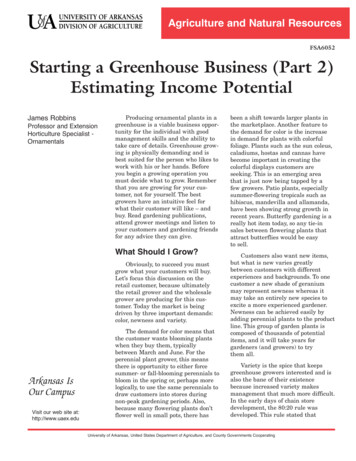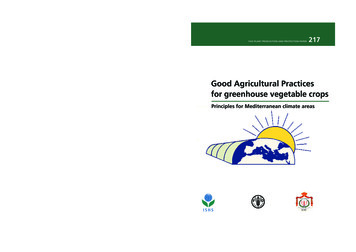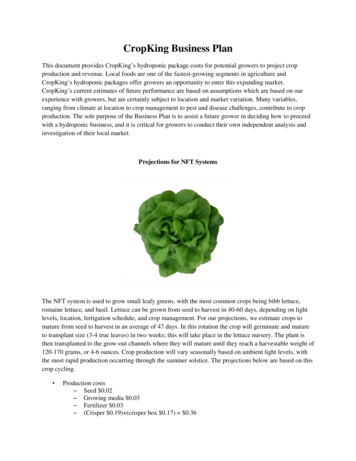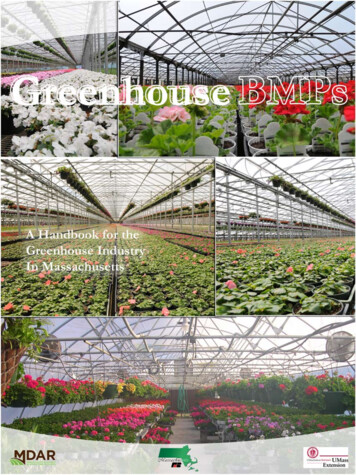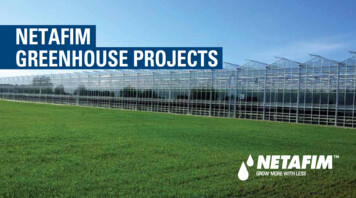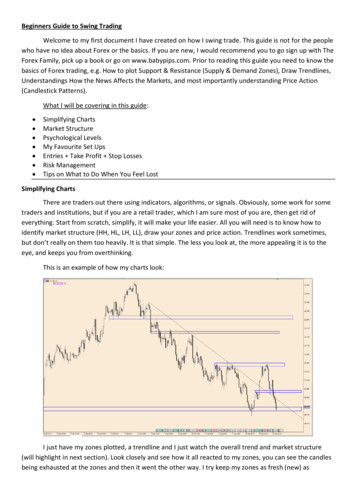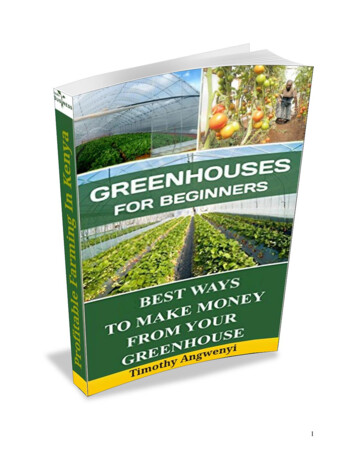
Transcription
1
Greenhouse For BeginnersBest Ways To Make Money From Your GreenHouseBy: Timothy AngwenyiWith agribusiness becoming one of the major investment opportunities for Kenyans, thedemand for greenhouses has risen significantly with many people looking to start greenhousefarming in Kenya. .More and more people are investing into this business with the hope ofmaking good returns from it.To manage the challenges of rainfall, degraded land and decreasing land sizes, I urgefarmers to go for greenhouse. A greenhouse, a protected space for growing vegetables, plantsand crops, is a prime real estate, so one should choose crops to maximize profits and producecrops that don’t do well outside.One advantage of using a greenhouse is that farmers can grow vegetables and crops atany time of the year – when they can’t be grown outdoors. This is because it allows them toextend the seasons and produce a wide range of vegetables.2
Greenhouse cultivation, enables farmers to grow their crops under optimized andstandardized conditions, which protects the plants from pests and bad weather.Farmers using greenhouse to grow out-of-season crops such as tomatoes, lettuce, basil, andother vegetables where they can command high prices in the market.In choosing what type of plants to grow for profit, a farmer must figure out the rightcombination of profitable plant varieties, sizes, and quantities.A Greenhouse is essentially a controlled environment limiting the devastating effects ofinsect pests and diseases that ravage vegetables including tomatoes. It is not rain-fed but brain-fed,as it comes complete with a customized drip irrigation system. With little amount of land spaceand water, you are sure to get a yield far higher than your traditional open field production.I wrote this eBook to ensure that farming is made attractive even among our youths,through modern technology with the greenhouse farming concept and access to quality inputs andtechnical support.3
CopyrightWritten By: Timothy Angwenyi morebu (0714723004)Agribusiness WriterCopyright 2016 by Timohbright.All rights reserved.First Edition: May 2016Profitable Farming Guide SeriesThis guide is geared towards providing exact and reliable information in regards to thetopic and issue covered. In no way is it legal to reproduce, duplicate, or transmit any part of thisdocument in either electronic means or in printed format. Recording of this publication is strictlyprohibited and any storage of this document is not allowed unless with written permission fromthe writer. All rights reserved.4
About The WriterHello! My name is Timothy Angwenyi Morebu.My phone number is 0714723004. My email also istimohangwenyi@gmail.com. I am a Agribusinesswriter, Agri-tourist & an Entrepreneur. Am currentlywriting guides on various ways of earning a living inKenya through Profitable Farming (Entrepreneurship),whereby i educate Kenyans on business ideas to venturein Agriculture sector.Helping people start Agribusinesses and achievethe income they desire has become a huge part of my life. Being able to share the knowledge Ihave gained through visiting people's farms and attending Agriculture seminars and exhibitionshas become extremely important to me.I consider my readers my friends. I am always so appreciative that they take their timeout to read my eBook guides and to learn about Agribusiness ideas from me. Once you havefinished reading this guide, I have no doubt that you will have learned a great deal aboutGreenhouse Farming in Kenya.Copyright 2016 Timohbright5
AcknowledgementsFirst and foremost, I would like to thank my wife Angela for standing beside methroughout my research, visiting greenhouses in Kenya and writing this ebook. She has been myinspiration and motivation for continuing to improve my knowledge and move my agribusinessskills forward. She is my rock, and I dedicate this ebook to her.I also thank my wonderful children: Katie & Kim, for always making me smile and forunderstanding on those weekend mornings when I was writing this ebook instead of playinggames. I hope that one day they can read this ebook and understand why I spent so much time infront of my computer.I’d like to thank my parents and grandparents for allowing me to follow my agribusinessambitions throughout my childhood. My family, including my in-laws, have always supportedme throughout my agribusiness career and authoring this ebook and I really appreciate it. I lookforward to discussing this ebook with my family at future gatherings as I’m sure they will allread it soon.My co-agribusiness friends, especially Roger Miseti, Smith Kimathi, and Matt Arena,who showed me the ropes in IT and Agri-touring to people's farms. I thank each of my friendsfor devoting their time and effort towards this ebook; I think that it will be a great asset to theKenyan community!Thanks for everything, I look forward to writing more and more agribusiness ebooks!6
Table of ContentChapter 1: Getting StartedPg. 8Chapter 2: Greenhouse Business PlanPg. 20Chapter 3: Cost of Building a GreenhousePg. 41Chapter 4: Selecting Your Greenhouse LocationPg. 58Chapter 5: Construction of Your GreenhousePg. 67Chapter 6: What to Grow in a GreenhousePg. 103Chapter 7: Best greenhouse management skills and crop protectionPg. 130Chapter 8: Marketing Your Greenhouse ProducePg. 192Chapter 9: Greenhouse Farming TipsPg. 198Chapter 10: Success stories of Kenyan Farmers owning GreenhousesPg. 207ConclusionPg. 2267
Chapter 1Getting StartedWhile the population is ever growing, land size remains fixed. Thus there is increasingpressure on land especially for agricultural or food production. In Kenya, about 80% of thepopulation depends on agriculture for both food and employment.One of the ways to get around this challenge of increasing shortage of land is to embracenew technologies and modes of farming that require small space but produce high yields. TheMinistry of Agriculture and private stakeholders are promoting Greenhouse farming as one ofthe strategies to counter land shortage and increase food production.A greenhouse is a structure in which crops are grown. These structures range from smallsheds to industrial-size structures. Greenhouse farming is the type of farming in which crops aregrown in built structure with different types of covering materials such as glass or plastic roofingand walls. There are two types of greenhouse farming. One is growing crops directly in the soilon open space where the plants are susceptible to soil-borne diseases.8
The second type of greenhouse farming is growing crops in artificial enclosed systemssuch as cocopeat, vermiculite etc which are disease free and require controlled fertilizerapplication through irrigation.The good news for farmers in Kenya is that the greenhouse technology can increase yourprofits highly. There are many Kenyan Greenhouse construction and consultancy companieshelping Kenyan farmers to set up greenhouses.The beauty with a greenhouse is that the structure can last at least 15 years. In one acre ofland, one can have close to 8 greenhouses especially those who would like to go into large scalecommercial farming.Greenhouse farming is clean because it doesn’t require using the ordinary hoe andtouching the soil. A farmer is provided with protective gear.Crops in a greenhouse are less contaminated with chemicals because the latter are mixedwith water in the tank that is passed onto the plants using the drip irrigation method. Dripirrigation allows water to drop only on the basement of the plant thus minimizing wastage ofwater and eliminating weeds.A farmer doesn’t spend on pesticides because the greenhouse is protected to preventcontact with pests and disease.It saves water because a farmer only requires 1000 litres to water a greenhouse of500sqm per day. Green house farming can also be used as a security to get a loan from a bank orfinancial institution.9
How Does a Greenhouse Work?How does a greenhouse work? Once you understand how a greenhouse works, you canbetter utilize this tool to help you get the most out of your gardening. From simplistic tocomplex, greenhouses are effective at promoting plant growth and fruit production.How Does a Greenhouse Work ScientificallyThe greenhouse works by collecting light and converting it to heat. That is a simplisticview of how a greenhouse works. In addition to capturing light, the greenhouse also storesthermal energy and releases that energy properly. It can help moderate temperature and producea controlled environment for plants to grow and thrive in. Further, a greenhouse offers protectionfrom wind, rain, snow and other weather elements while also keeping your fruits from invadingpests and animals.Solar CollectionThe main task of a greenhouse is to collect solar energy. The greenhouse captures lightthrough its walls and converts it to heat. The effect is similar to that of a vehicle with thewindows up. It takes only a few minutes for light coming in a window to warm up the vehicle toa temperature significantly higher than the outside temperature. Greenhouses work the same10
way. The darker material within the greenhouse helps to store heat, keeping the surrounding airwarmer.The greenhouse is a closed-in environment, which means there are no breezes to push theheat away. The structure is often made of glass, or glass-like material that helps to attract thesun's rays. Without a breeze, the air within the greenhouse heats up quickly and remains warm.This creates the ideal area for plants to grow.Releasing Thermal EnergyAs the greenhouse draws in and collects sunlight, it warms the air within. This occursnaturally. The process is releasing thermal energy. The matter within the greenhouse, such as thesoil and water, will absorb the heat drawn in. Even when the sun goes down, the warmth in thesoil and water continue to protect the plants because these materials release the warmth slowly.Another important factor in protecting your plants is the way greenhouses regulatetemperature. The thermal mass within the greenhouse helps to keep the temperatures moderate.If your greenhouse is larger and has thermal mass within it, such as the iron found in soil, it willheat up slowly and will cool down slowly. Rather than high heat in the daytime and coldtemperatures at night, the thermal mass within the greenhouse regulates the temperature evenlythroughout the day and night. This provides a better atmosphere for plants to grow.Protection from the ElementsAnother way in which greenhouses work is by providing protection from the elements. Inthis manner, greenhouses function much as a house does for humans. Protection from theelements is critical, especially when you are gardening in the fall or winter months. Considersome of the ways a greenhouse protects. The greenhouse prevents strong winds from pulling up roots or blowing seeds. It allows you to control how much water your plants receive. Rain and hail are unable toget in.11
Pests, including vegetable eating pests, are kept out. You do not have to spray harshchemicals on your plants. You control the types of insects or other pests allowed into thegarden. It may not be possible to keep all pests out long term, but you will minimize thenumber. A greenhouse keeps excess heat and cold from affecting plants. When the temperaturegets too high, the fogging or misting systems within some greenhouses can help to cooldown the temperature. Other systems heat up the greenhouse when there is limitedsunlight.The ability to protect plants from any of these elements is critical to helping those plantsto grow successfully. Greenhouses adjust the weather conditions to allow for better growth.When you ask, "How does a greenhouse work" keep in mind there are numerous types ofgreenhouses. Some are, very simply, structures with polythene walls. Others have complexheating and cooling systems within them to help control temperatures. When selecting a type ofgreenhouse to use, focus on your budget and your needs to control the climate.How greenhouse farmer beat setup earns millionsAlice Chuaga has earned tidy profits from growing crops in greenhouses. Listening toAlice Chuaga speak about her farms worth millions of shillings, one would be forgiven to thinkthat she is an agronomist or a greenhouse technology expert.12
But the greenhouse farmer from Nyeri says her passion and use of cheap materials iswhat has driven her to attain this kind of success.Chuaga says she opted for improvised greenhouses with lower maintenance costs, thatuses water more efficiently and one that can be easily moved to cut on setup costs.An average greenhouse unit of eight metres by 30 meters costs about Sh.200,000. Thiscost includes laying pipes for drip irrigation. Chuaga says farmers who are unable to afford thesteel structures can build their own greenhouses using timber poles at a much lower cost.“I set aside Sh.16,000 to personally construct and install the pipes for drip irrigation for asingle greenhouse unit and now I own three,” she says.“I have two greenhouses on my a quarter plot in Nyeri where I plant tomatoes andcapsicums,” Chuaga says, adding that she has already erected the third one in her kitchen gardento grow passion fruits.“My first Anna F1 tomatoes harvest from the improvised greenhouse in my kitchengarden was quite notable. I harvested 19,000 kilogrammes (kg) of tomatoes which I sold atSh.110 per kg.”The tomatoes mature after 75 days and after each harvest she says she collects betweenSh.209,000 to Sh.450,000.Although prices fluctuate because of supply and demand, she says during low seasons sheharvests 3,016 kgs of tomatoes with a kilo going for as low as Sh.60 but on the higher side a kgwould go for Sh.110.“I sell the tomatoes to hotels in town, individuals and some to my neighbours,” she says.13
The mother of three also grows capsicums. She says any vegetable can be grown ingreenhouses and capsicum has fetched her good profits
Chapter 2: Greenhouse Business Plan Pg. 20 Chapter 3: Cost of Building a Greenhouse Pg. 41 Chapter 4: Selecting Your Greenhouse Location Pg. 58 Chapter 5: Construction of Your Greenhouse Pg. 67 Chapter 6: What to Grow in a Greenhouse Pg. 103 Chapter 7: Best greenhouse management skills and crop protection Pg. 130 Chapter 8: Marketing Your Greenhouse Produce Pg. 192 Chapter 9: Greenhouse .

